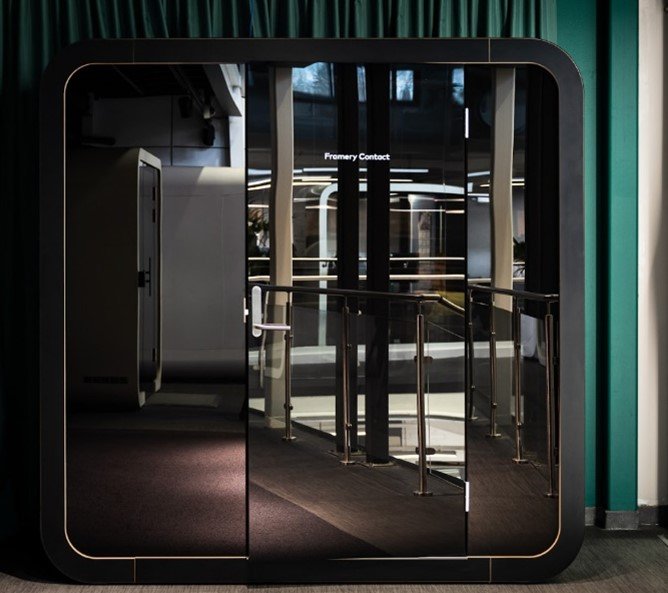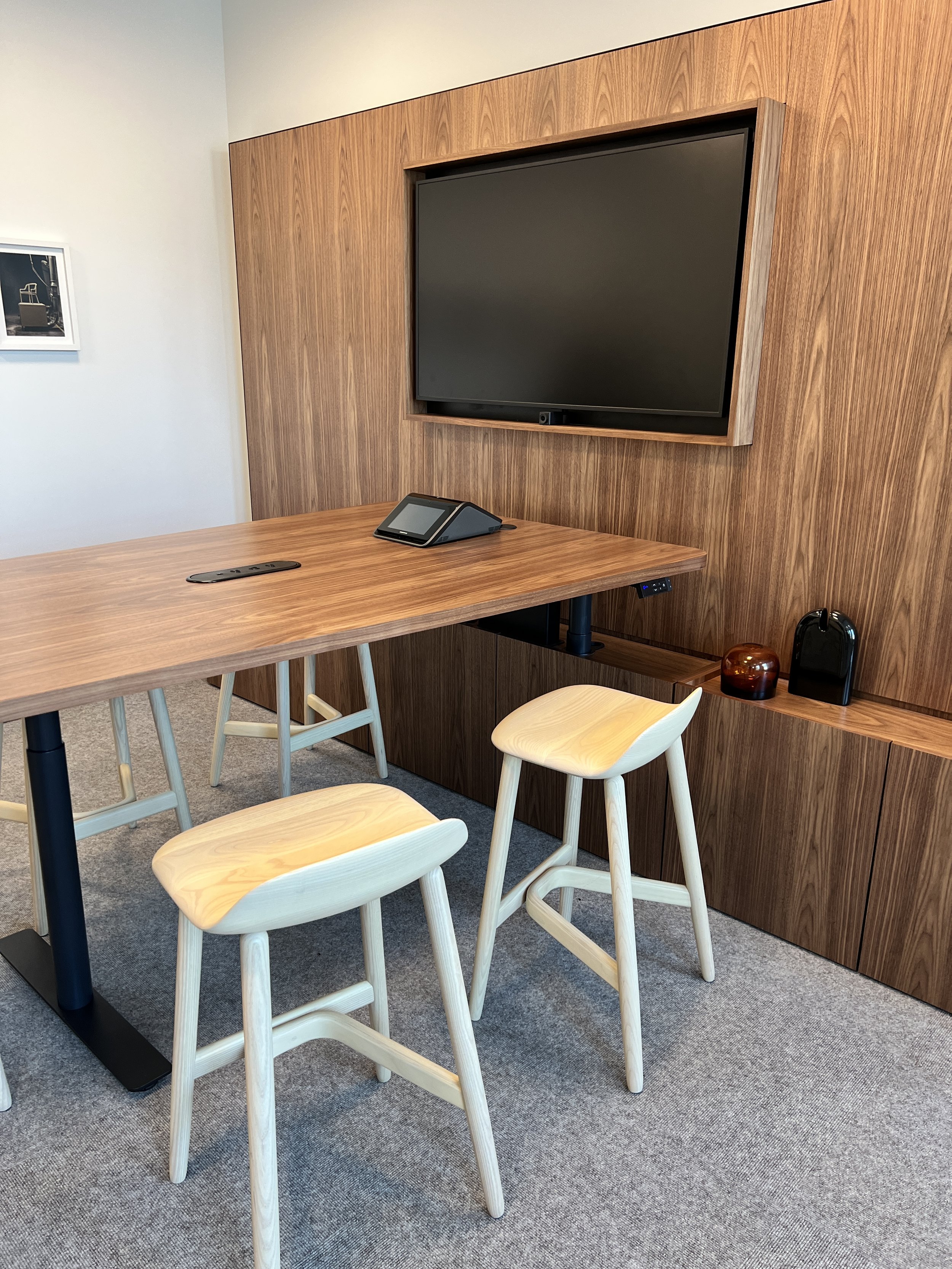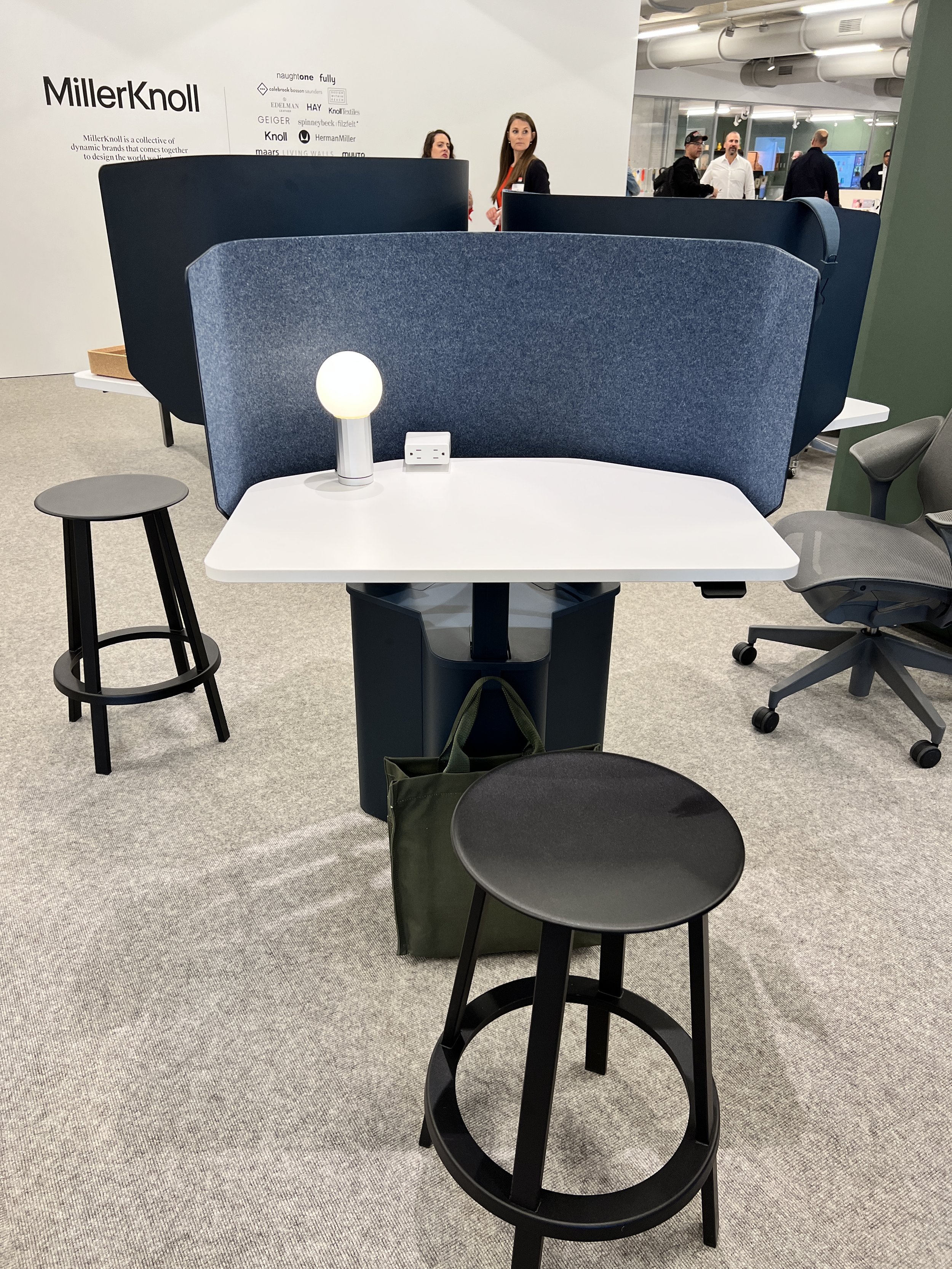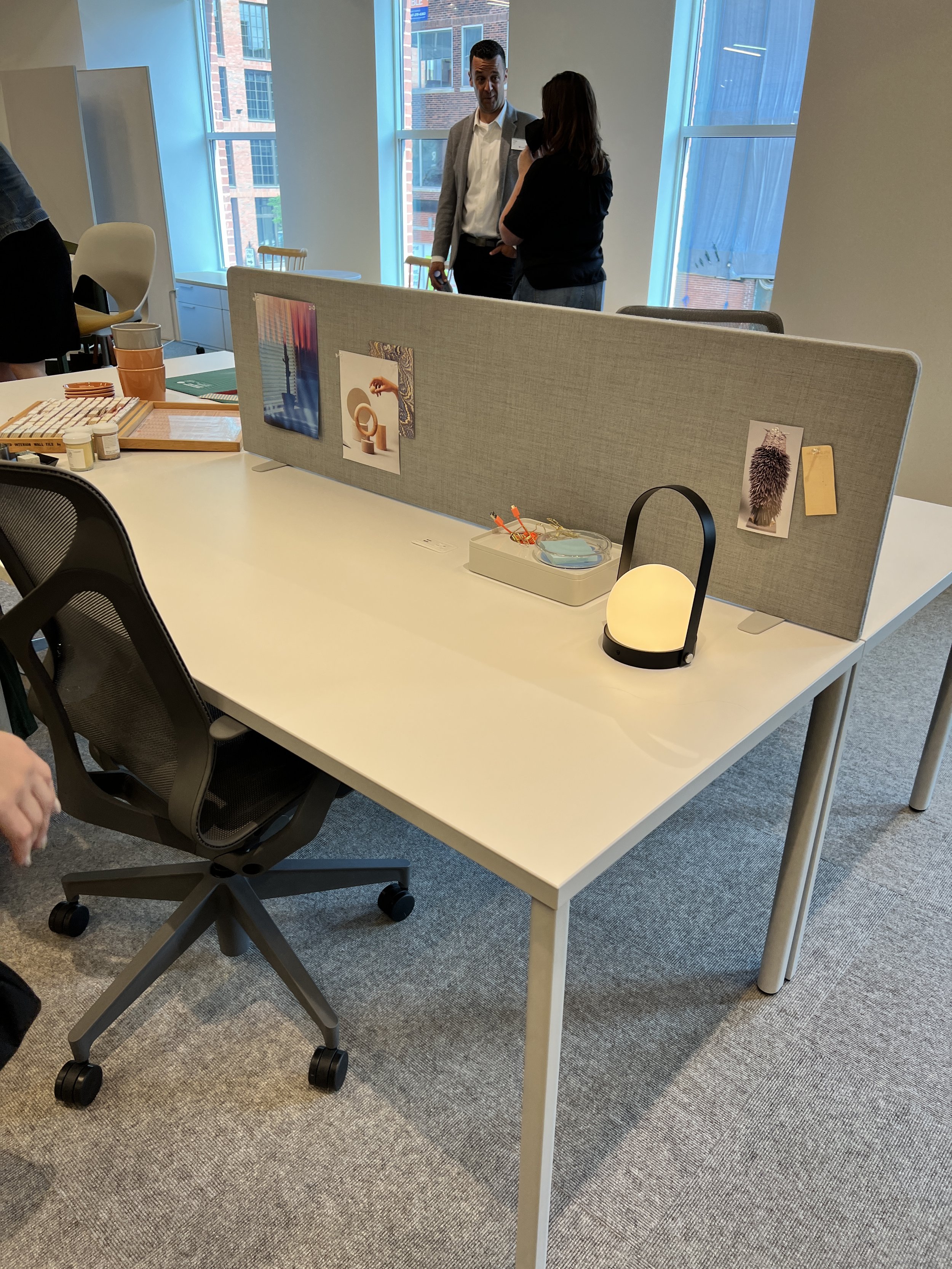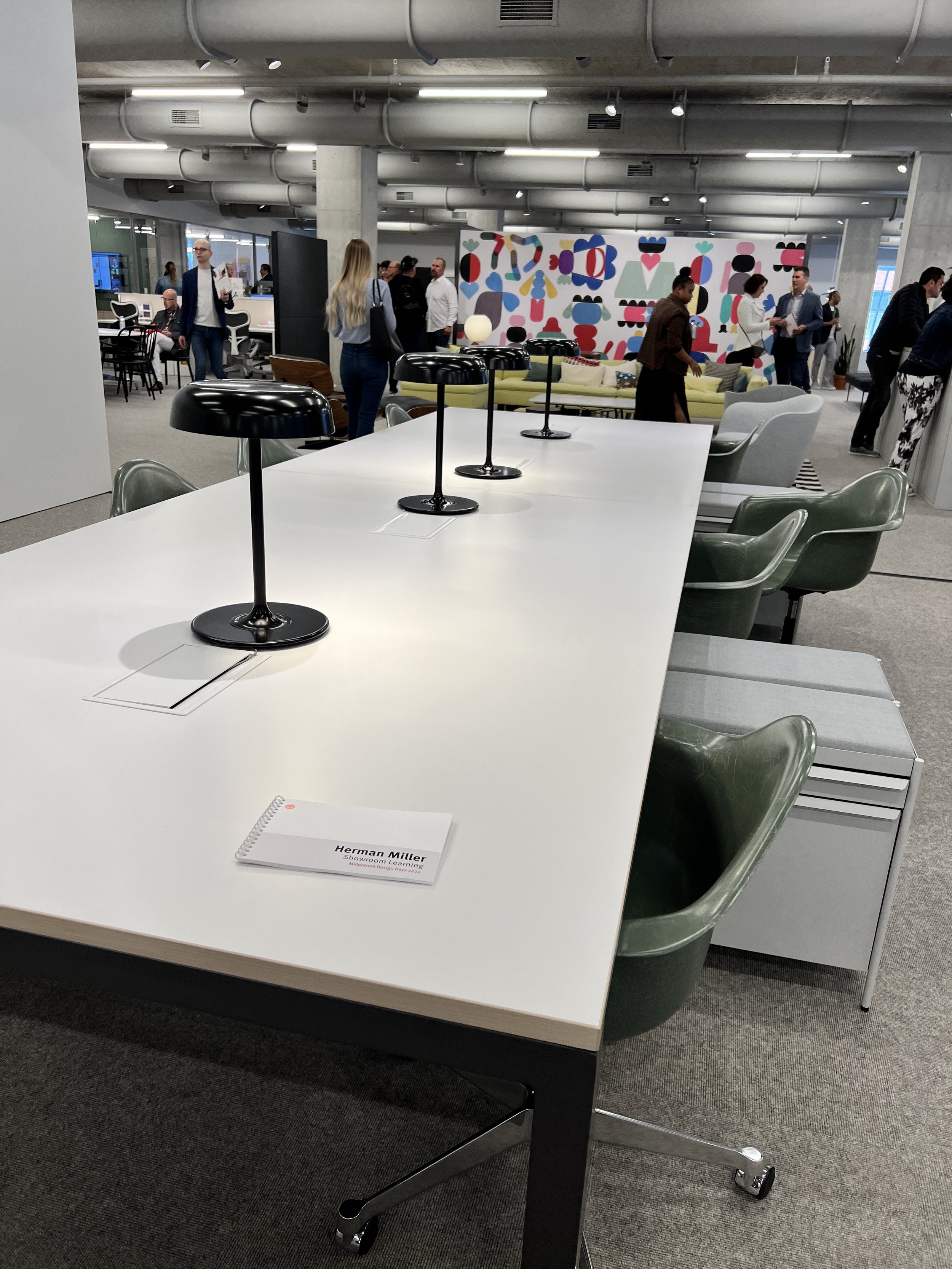Exploring Post-Neocon perspectives | Part ii
As organizations increasingly prioritize sustainability and environmental consciousness, as seen at NeoCon and Design Days, furniture design is aligning with these principles to create more eco-friendly and responsible workspaces. Additionally, the intersection of social dynamics and technology integration in the design of contemporary office furniture was highlighted by the one and only, Framery.
Welcome to Part 2 of our two-part post Neocon blog series on the ever-evolving world of workplace design and furniture. We wanted to bring you more insights since our team endured rain, gale-force winds, and walked over 155,000 steps combined to experience it all (and so you didn't have to).
In Part 1, we discussed the need for flexibility, collaboration, and reconfigurable furniture in today's fast-paced work environments, and we introduced the innovative Morse Table System by NaughtOne and the Team Cart by Global Furniture Group as solutions to seamlessly transition between different work modes.
In our previous post, the most prominent insights highlighted were as follows:
COLLABORATIVE AND FLEXIBLE FURNITURE FOR CROSS-GENERATIONAL SPACES
MOBILITY AND RECONFIGURABLE FURNITURE IS ESSENTIAL
GREEN IS KING- SUSTAINABILITY IS EVERYWHERE
SOCIAL + TECHNOLOGY= A WINNING COMBINATION
As organizations increasingly prioritize sustainability and environmental consciousness, as seen at NeoCon and Design Days, furniture design is aligning with these principles to create more eco-friendly and responsible workspaces. Additionally, the intersection of social dynamics and technology integration in the design of contemporary office furniture was highlighted by the one and only, Framery. With the rise of remote work and virtual collaboration, the way we interact with our colleagues and utilize technology has transformed. Furniture designers are harnessing the potential of this winning combination to enhance communication, productivity, and overall workplace experience.
Green is King - Sustainability is Everywhere
Sustainability is becoming a driving force in furniture design, with manufacturers and designers incorporating eco-friendly materials into their products. NaughtOne has consistently strived to make a positive impact on the world. They have been at the forefront of environmental certifications, designing, and manufacturing sustainable products. A great example of NaughtOne’s product line is the Pippin chair. Designed by a talented British Furniture designer, Lucy Kurrein. The Pippin chair gained recognition and exposure in the NaughtOne showroom at the Fulton Market Design Days.
Pippin was created with longevity in mind and a focus on the end of its lifecycle. Every component was meticulously designed to facilitate easy disassembly when its lifespan is complete. Pippin comes with a unique feature—a tailored cover that can be zipped on and off, giving the chair its sophisticated charm. This removable cover not only allows for easy replacement in the event of damage or stains but also enables customization options to suit different styles. In addition, the construction of the chair is entirely free from glues and staples, ensuring easy disassembly and facilitating proper recycling at the end of its lifecycle. NaughtOne's commitment to sustainability is evident in the thoughtful design of Pippin and according to its Product Sustainability Statement 89.8% is recyclable content embodying their dedication to creating products that are both environmentally responsible and aesthetically appealing.
SOCIAL + TECHNOLOGY= A WINNING COMBINATION
As mentioned before, hybrid work is not going anywhere, it is here to stay and with the powerful combination of social dynamics and technology in the modern workplace Framery presented an innovative product at Neocon offering visitors to experience it in person. With the increasing integration of digital tools and collaborative platforms, Framery Contact by Framery is disrupting how technology works to connect people in offices on opposite sides of the country, or even the other side of the world.
Framery Contact is a virtual meeting pod that comes closer to recreating the experience of a real face-to-face conversation than any other technology on the market. The pod is designed to isolate visual and acoustical elements enhancing the sense of being in a shared space with the person on the screen. Our team tried it out firsthand and it’s no exaggeration to say that we were blown away. It was as if the person on the screen (which we couldn’t detect where it began and ended) was sitting in the same booth with us. According to Framery’s research, a single flight between London and New York produces 1.7 tons of carbon dioxide whereas the total emissions from manufacturing, five years of use, and recycling a Framery Contact pod is only 1.4 tons. This innovation is convenient, an absolute perfect combination of social and technology integration with a sustainable aspect to it as well.
From smart furniture that integrates with smart devices to immersive meeting spaces that foster engagement, the insights highlights are shaping the future of workspaces. The future workplace is here, and it's transforming the way we work, collaborate, and thrive.
THE NEW WORKPLACE DESIGN: HOTELIFICATION
Since 1969, Neocon has been established as the industry leading commercial interior design event showcasing ideas that will transform workplace environments. Neocon continues that tradition today, still recognized as the most valuable with a high-attendance rate event for designers, manufacturers, and dealers to discover people, products, and upcoming trends. This year, Neocon’s exhibitors showcased designs with warm, welcoming, and collaborative layouts to visually share the future of office spaces – the hotelification concept. This concept portrays the need to blend the digital and physical realms, promoting a new way of working and creating a positive work experience for everyone.
Neocon returns after a hiatus with the hotelification concept.
Since 1969, Neocon has been established as the industry leading commercial interior design event showcasing ideas that will transform workplace environments. Neocon continues that tradition today, still recognized as the most valuable with a high-attendance rate event for designers, manufacturers, and dealers to discover people, products, and upcoming trends. This year, Neocon’s exhibitors showcased designs with warm, welcoming, and collaborative layouts to visually share the future of office spaces – the hotelification concept. This concept portrays the need to blend the digital and physical realms, promoting a new way of working and creating a positive work experience for everyone.
After taking a hiatus during the pandemic, Neocon 2022 was the launchpad for the hotelification concept. This year, Neocon was back, lines were longer, elevators were full, and showrooms were buzzing with activity. Chicago was alive again. TheMart had thrill, design, and innovation on full display. Again – it was back with a stronger statement – new designs for the new way of working. Because the world is constantly changing, office models are also evolving – staying up to date and putting employees/clients first, and those tenants will remain a priority now and in the future.
The new hotelification concept derives from the resimercial trend that started before the pandemic. The combination between life and work has become interconnected, and the lines are no longer visible. The new way of designing office spaces has ceased to be linear. This new model includes privacy spaces, collaborative spaces that provide technology to support virtual meetings, stand-alone stations & single-person stations that support collaboration, café-like meeting areas, and kitchens. With the inclusion of a new layout, employers aim to bring employees back into the office and create an exciting work culture.
Flexibility, inclusion, and mental health were conversation points at Neocon. Many businesses are now designing their office spaces to provide flexibility, inclusivity, and wellness spaces for employees to decompress and take mental breaks. Pre-pandemic, the resimercial concept combined residential and commercial bringing a home-like feel into the workplace with café-style rooms, office lounge areas, and kitchens to optimize the work-life culture. Fast-forward to today with an increased demand for work-life balance, making the ability to transform the office space that encompasses both a residential and commercial feel vital. The layout of the office space is moving away from a desk, chair, and white walls into a more inviting, warm area with wood accents and soft, muted colors, such as golds, purples, blues, greens, and reds.
Creating a flexible work culture starts by providing spaces that support technology for those that are working remotely to seamlessly collaborate with those that are in the office. Flexibility includes working areas, desks, lounge furniture, individual pods, and café areas. The goal is to provide furniture in office spaces to create a comfortable work experience. Pre-pandemic, sitting at a desk was a tradition; now, more people have acclimated to working on various furniture pieces and collaborating virtually.
Corporate Environments has implemented this concept in recent projects, such as its collaboration with Knoll in the Cooper Carry office renovation. Cooper Carry had a vision, the vision of creating their headquarters into a hybrid way of working to increase the number of employees coming back into the office.
Read the story: The Future is Flexible – Knoll
There has also been a rise in inclusive design to foster workplace environments and promote greater employee inclusion in all organizations. Workstations provide an opportunity for team collaboration, individual work time, and a space where everyone feels welcomed and part of a team. Many showrooms implemented rounded corner furniture and layouts. The purpose was to create a more inviting sense of inclusivity for employees and clients. As seen in GreyStone Power’s recent project, they wanted to develop a collaboration-friendly environment designed to attract new talent and retain longtime employees. Read the story of how Greystone reimagined their workspace partnering with Corporate Environments and design firm Smallwood. Powered Up! – Knoll
Providing wellness spaces in different office areas promotes employee productivity and increases employee retention. Offices are moving away from the conference-like room into spaces where employees can have a moment to decompress or collaborate. The biophilic design has become a solution and lesson learned to bridge the gap between nature and work. Bringing in the biophilic designs creates a more natural, comfortable, and relaxing space people have acclimated to during the pandemic. Many firms are implementing woods accents, warm-muted color palettes, biophilia, and privacy & collaborative spaces.
Not only has there been a change in workplace design, but also in how people work. Post-COVID, remote work has become prevalent. It is a new working method – a method that is not leaving. Many businesses have transitioned to hybrid working, while others have entirely transitioned to 100% remote working. The changing landscape of how and where people work will continue to evolve as we work towards the post-COVID era and workplace design will evolve alongside it. There has been an increase in people switching jobs for many reasons, one being the flexibility of hybrid working. The pandemic was a launchpad for employees to assess their values and determine if their employer offers those opportunities; people are not settling anymore.
Are you ready to transition and renovate your space into a more resimercial workplace? Connect with us and let Corporate Environments create a workspace that will meet the needs of both your employees and your business.
Do you agree with the hotelification approach? In the comments below, share why or why not.





